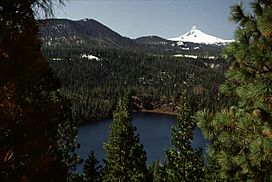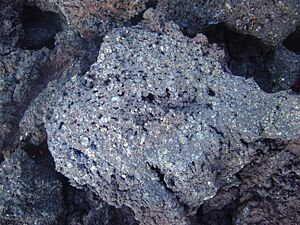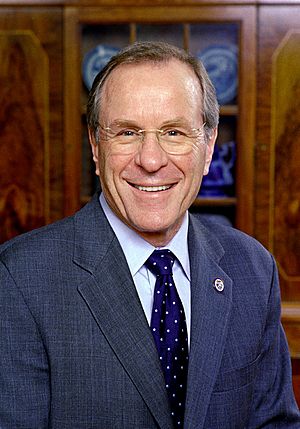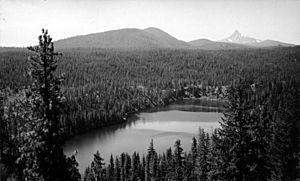Blue Lake Crater facts for kids
Quick facts for kids Blue Lake Crater |
|
|---|---|

Blue Lake Crater (before the B&B Complex fires in summer 2003)
|
|
| Floor elevation | 3,461 ft (1,055 m) |
| Geology | |
| Type | Maar |
| Age | Holocene |
| Geography | |
| Location | Jefferson County, Oregon, USA |
| Topo map | USGS Three Fingered Jack |
Blue Lake Crater (also known as Blue Lake Maar) is a special type of volcanic crater called a maar. It's located in Oregon, USA. This crater holds a beautiful lake called Blue Lake.
The area around Blue Lake Crater has steep, forested slopes. It's part of the Metolius River basin, which is home to many plants, animals, and over 80 kinds of birds. In 2009, Oregon's Governor Ted Kulongoski signed a law to protect this area. This law helps prevent big building projects and keeps the wildlife safe.
Even though Blue Lake Crater erupted sometime in the last 4,000 years, it's one of the least-known volcanoes in the Cascade Volcanic Arc. The lake is surrounded by a crescent-shaped ridge made of volcanic rocks. The northern side of the crater's rim collapsed during an eruption, but the southern side is still whole.
Scientists aren't sure exactly when Blue Lake Crater last erupted. Some think it was about 3,440 years ago. Others believe it was more recently, around 1,330 years ago. The United States Geological Survey says the chance of it erupting again is "Low/Very Low."
Blue Lake Crater is part of the Elliott Corbett Memorial State Recreation Site. It has an arts center called Caldera and a resort. You can also find a campground at nearby Suttle Lake. People enjoy fishing in Blue Lake. The area is also great for hiking and horseback riding.
Contents
Where is Blue Lake Crater Located?
Blue Lake Crater is in Jefferson County, Oregon. The lake at the bottom of the crater is about 3,461 feet (1,055 meters) high. The rim of the crater is about 4,035 feet (1,230 meters) high.
The crater actually has three overlapping parts, all filled by Blue Lake. The lake covers about 60 acres (0.24 square kilometers). It's about 0.3 miles (0.5 kilometers) wide and 0.8 miles (1.3 kilometers) long. The lake is more than 90 meters (295 feet) deep. Its shoreline is about 1.5 miles (2.4 kilometers) long.
Blue Lake is very cold, especially below 10 meters (33 feet) deep. Its deep water gives it its famous blue color. The Atlas of Oregon Lakes calls it "the bluest of the many Blue Lakes in Oregon." The lake gets its water from underground springs and snowmelt. A small stream also flows into it from the northwest.
Link Stream flows out of Blue Lake, going about 0.5 miles (0.8 kilometers) to Suttle Lake. Suttle Lake is a popular spot for tourists.
What Animals and Plants Live Here?
Blue Lake has a lot of phosphorus, which is usually found in lakes with lots of plant life. But Blue Lake has very few tiny plants called phytoplankton. You can find rainbow trout and kokanee fish in the lake. In the past, sockeye salmon also lived here, but they stopped coming after the Pelton Dam was built in the 1960s. There are plans to bring these fish back.
The forests around Blue Lake Crater have been damaged by forest fires. But the area is still part of the Metolius River basin. This river flows through old forests with large ponderosa pine, Douglas fir, and western larch trees.
In May, many native plants and wildflowers start to bloom. These include early blue violets, larkspur, and serviceberry. In the summer, you can see arrowleaf balsamroot, American brooklime, and bigleaf lupine.
A special wildflower called Penstemon peckii grows here. It comes in seven different colors and is only found in the Sisters area. Other plants in the Metolius Preserve include incense cedar trees, nutka rose, and vine maple trees.
More than 80 kinds of birds live in the Metolius Preserve, like the white-headed woodpecker. Large mammals such as American black bears, badgers, bobcats, beavers, deer, cougars, and otters also live here. Smaller mammals like northern flying squirrels and shrews can be found too.
How Blue Lake Crater Formed

Blue Lake Crater is part of the Cascade Volcanic Arc in western North America. It's about 3 miles (4.8 kilometers) east of the main mountain range. Even though it's near a major highway, it's one of the least-known volcanoes in the Cascades.
Blue Lake Crater is a Holocene maar. This means it's a wide, low volcanic crater that formed from an explosion. It has at least three overlapping explosion craters. A crescent-shaped ridge of volcanic rocks surrounds the crater. Some of these rocks are huge, up to 6 feet (1.8 meters) long!
The northern wall of the crater likely collapsed during an eruption. The southern wall is still strong and made of cinder and volcanic rocks.
Blue Lake Crater's eruption happened less than 3,000 years ago. This makes it one of the youngest volcanoes in the Cascade Range. Its rocks are mostly basalt and picrite basalt, which are rich in magnesium and iron.
Nearby Volcanic Features
About 3.7 miles (6 kilometers) south of Blue Lake Crater, there's a chain of small spatter cones. These cones erupted material similar to Blue Lake Crater's, suggesting they erupted around the same time. None of these spatter cones produced lava flows.
Another small cinder cone called Cinder Pit is about 1.5 miles (2.4 kilometers) north of Blue Lake Crater. It's now filled with basalt rock.
When Did Blue Lake Crater Erupt?
Volcanic activity in this area has included eruptions of basalt and basaltic andesite lava flows. Most of these eruptions happened in the last 7,650 years.
Blue Lake Crater erupted sometime in the last 4,000 years. Early studies suggested it erupted about 3,440 years ago. More recent findings suggest it might have been around 1,330 years ago.
The eruption of Blue Lake Crater was very powerful. It broke through layers of rock, sending out volcanic bombs and cinders. It also created a thick blanket of tephra (volcanic ash and rock fragments) that spread to the east and southeast. This tephra could be more than 5 meters (16 feet) thick in some places.
The eruption likely created a tall column of tephra. Wind carried this material to Suttle Lake, where it formed a deposit more than 7 feet (2.1 meters) thick. The eruption produced scoria (bubbly volcanic rock), black volcanic ash, and lapilli (small rock fragments).
This eruption was one of many volcanic events in the area after the last Ice Age. It formed an elongated crater with steep walls but a low rim. No lava flows came out during this eruption.
Scientists estimate that the eruption produced about 40 million cubic meters (1.4 billion cubic feet) of material. The eruption probably started with water mixing with magma, but then became mostly magma-driven.
Is Blue Lake Crater a Threat Today?
No lava flows have happened recently near Blue Lake Crater. The area around the crater isn't heavily populated. In 2013, about 6,900 people lived within 30 kilometers (18.6 miles) of the volcano.
The Volcano Hazards Program of the USGS says the threat from Blue Lake Crater is "Low/Very Low."
Fun Things to Do at Blue Lake Crater

Blue Lake Crater is part of the Elliott Corbett Memorial State Recreation Site. This site is named after Elliott Corbett, a 22-year-old soldier who died in World War II.
The Caldera arts center is located on Blue Lake. There's also a resort and a campground at nearby Suttle Lake. The arts center is about 3,500 feet (1,067 meters) above sea level. It's 16 miles (25.7 kilometers) west of the city of Sisters. The center covers 116 acres (0.47 square kilometers) and is surrounded by the Deschutes National Forest.
Many groups work to protect the Metolius River basin. These include the Metolius River Association and Friends of the Metolius. The Deschutes Land Trust manages the Metolius Preserve. They work to protect homes for fish, plants, and animals. They also help bring back chinook salmon and sockeye salmon to the area.
In 2009, Governor of Oregon Ted Kulongoski signed a bill to make the Metolius River basin an "Area of Critical State Concern." This prevents large building projects and protects the wildlife.
The area around Blue Lake and Suttle Lake is popular for outdoor activities. Fishing in Blue Lake is best in warmer months because of the lake's depth. The United States Forest Service manages several campgrounds in the area, including one on Blue Lake.
You can find hiking and horseback riding trails along the lake's shoreline. However, about half of the land around the lake is privately owned, including parts of the resort. Even though some parts are private, you can still enjoy a round-trip hike on the public trails. This hike is more than 2 miles (3.2 kilometers) long and starts with a steep climb up a cinder slope.
Images for kids
-
Blue Lake crater is made up of basalt and picrite basalt, or picrobasalt (representative sample pictured)
-
Governor of Oregon Ted Kulongoski signed a bill to preserve a recreational area that includes Blue Lake Crater






